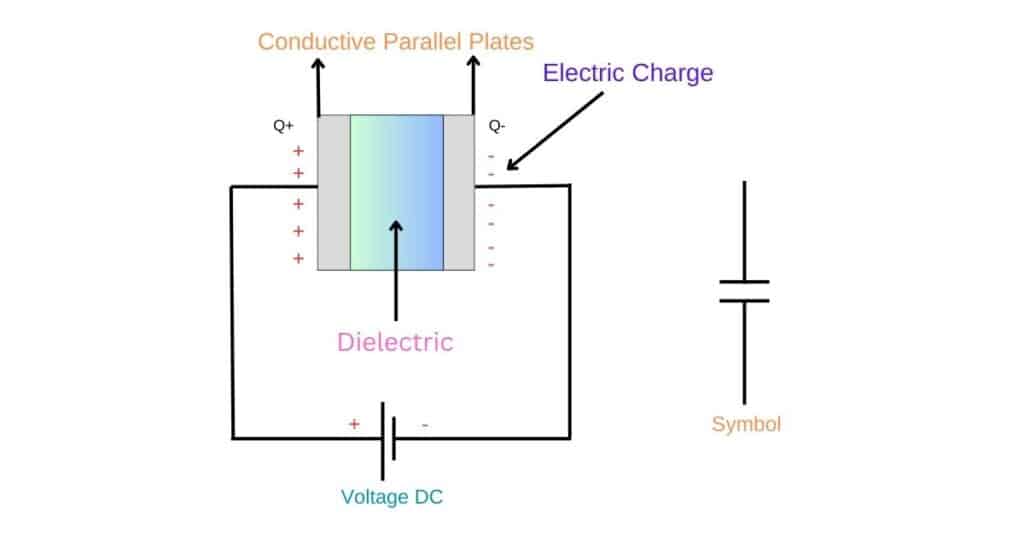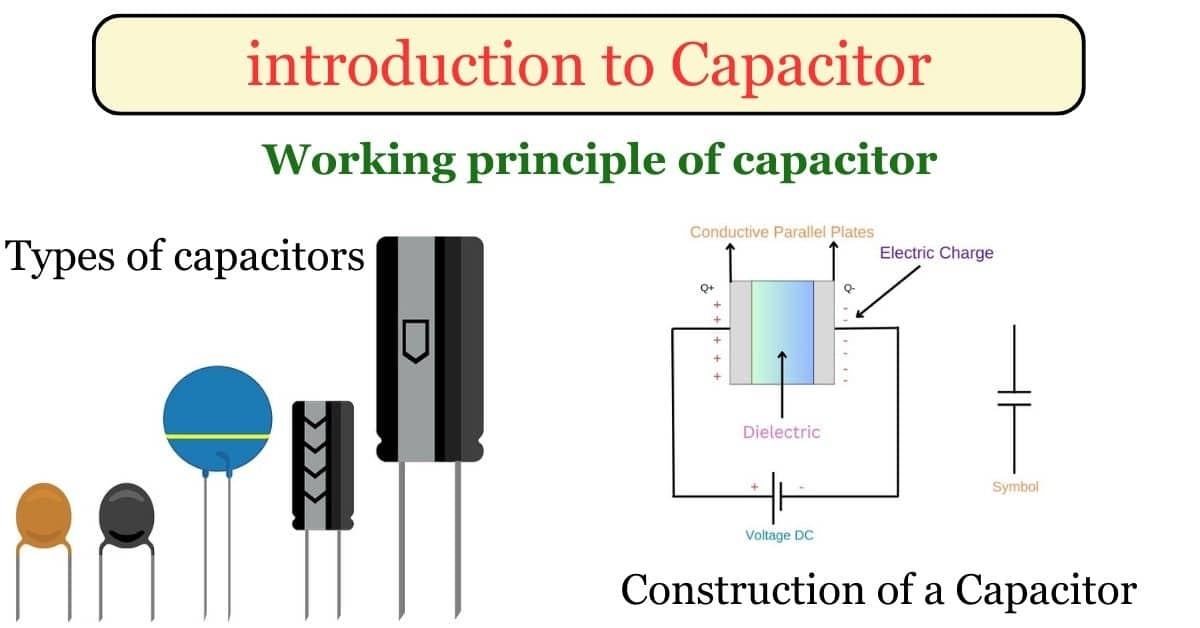Brief explanation of what is a Capacitor
A capacitor is similar to a compact battery that can rapidly store and release electrical energy that making it essential for devices that quickly burst of power.
When we connect it to a power source, the capacitor stores energy and can release it when needed.
Capacitors are commonly used in electronics to help manage the power and clean up the signals.
In this article, we are going to learn all about capacitors – properties, working principles, types, and much more.
importance of capacitor in electronic
Capacitor excels in signal integrity management. They effectively filter out unwanted noise and disturbances from power sources, ensuring that sensitive components such as microprocessors and integrated circuits receive clean and consistent power.
Capacitors also play a pivotal role in timing circuits by determining frequency in precision applications like oscillators and signal timing mechanisms.
Additionally, capacitors support electrical systems by aiding in motor starting and optimizing power factor correction, thereby ensuring overall energy efficiency.
Definition of Capacitor
A capacitor is a component in electrical circuits that stores and releases electrical energy. It consists of two metal plates separated by an insulating material called a dielectric.
A capacitor is basically a basic electronic component that temporarily stores electric charge.
When you connect a capacitor to a battery or another power source, it charges up by collecting electricity. It holds onto this electricity until you need it for something else in a circuit, like sending out electrical signals or helping things work smoothly.
Construction of a Capacitor
Description of basic components (plates and dielectrics)
- Plates:
These are conductive surfaces, usually made of materials like aluminium or copper.
Capacitors have two plates-one positive and one negative – that store electric charge.
- Dielectric:
This is a material that is not electrically conductive and is situated between the plates. It can be made of various materials, such as ceramic, plastic, or paper.
The dielectric serves to insulate the plates from each other while allowing an electric field to flow between them.
Together, plates and dielectrics form the essential structure of a capacitor. They work together to store electrical energy temporarily when the capacitor is charged.
Different types of dielectric materials used
Dielectric materials are like insulators that can become aligned or organized when an electric field is applied to them. They are commonly used in capacitors.
Here are some types:
- Ceramic dielectric:
These are made from ceramic materials that have high capacitance and are used in small spaces. Examples include barium titanate and titanium dioxide.
- Glass dielectrics:
These are glass-based materials known for their excellent insulation and stability, making them ideal for applications involving high frequencies and high temperatures.
- Mica dielectrics:
Mica is a natural mineral that provides excellent thermal stability, low and high voltage resistance. It finds use in applications where reliability and stability are crucial.
- Polymer dielectrics:
These include materials like polyethylene, polypropylene, and polystyrene. They offer flexibility, are low cost and are used in a wide range of applications, from power capacitance to electronic devices.
- Paper dielectrics:
Impregnated with oil or other substances, paper dielectrics are used in power capacitors and high-voltage applications due to their good dielectric strength and stability.
- Air dielectrics:
Air is used as a dielectric in capacitors, which requires very low energy losses and high insulation resistance. These are typically used in various capacitor and RF applications.
- Vacuum dielectrics:
Vacuum provides an ideal dielectric with no energy loss and is used in high-voltage applications like vacuum capacitors.
Each type of dielectric material has unique characteristics that make it suitable for specific applications. Consider factors such as capacitance, thermal stability, energy loss, and mechanical properties.
Types of capacitors
- Electrolyte capacitor
These use an electrolyte for higher capacitance and are polarized with positive and negative leds.
Commonly used in power supplies, they offer high capacitance and high voltage ratings that make them ideal for filtering and smoothing circuits
- Ceramic capacitors
These ceramic capacitors are made from ceramic material. These non-polarized capacitors are small, stable and have high dielectric constants.
They are used in high-frequency circuits and as bypass capacitors due to their reliability and performance.
- Film capacitor
Using a thin plastic film as the dielectric, these capacitors provide stable and precise capacitance with low energy loss.
Ideal for audio and radio frequency circuits, they offer reliability and low inductance.
- Tantalum capacitors
These use tantalum metal as the anode, which offers high capacitance per volume and stability over a wide temperature range.
Polarized and compact, they are used in portable electronics and applications requiring stable performance.
- Super-capacitors
Also known as ultra-capacitors, these have very high capacitance and can store and release large amounts of energy quickly.
They are used in backup power supplies and electric vehicle regenerative braking systems for rapid energy storage and discharge.
Working principle of capacitor
A capacitor stores energy by holding electrical charge on two metal plates separated by an insulating material called a dielectric.
When voltage is applied, electrons move to one plate, making it negatively charged, while the other plate becomes positively charged.

This creates an electric field between the plates for storing energy.
- How a capacitor stores and releases energy
When the capacitor is connected to a circuit, it releases the stored energy by letting the charges flow back through the circuit that provides a current. This process is known as the charge and discharge cycle.
- Charge and discharge cycle
During charging, the capacitor stores energy, and during discharging, it releases energy.
The dielectric material is very important for a capacitor’s performance. It helps the capacitor to store more charge by weakening the electric field inside the capacitor. This allows more charge to build up the plates.
Different materials can change how much charge the capacitor can store and how well it works.
Factors affecting to the capacitor
- Plate Area:
Larger plates increase capacitance by providing more space for charge storage.
- Distance between plates:
Closer plates increase capacitance due to stronger electric fields.
- Dielectric material:
Capacitance depends on the type of material between plates .
Higher dielectric constant materials increase capacitance.
- Temperature:
Capacitance can change with temperature, affecting the dielectric properties of the material.
- voltage:
In some capacitors, capacitance can vary with applied voltage due to a nonlinear effect in the dielectric.
Formula of capacitance
Where:
C is the capacitance.
Ε is the permittivity of the dielectric material between the plates.
A is the area of one of the plates.
D is the distance between the plates.
This formula shows how capacitance depends on the area of the capacitance plates, the distance between them, and the properties of the dielectric materials.
Applications of capacitor
Capacitor are used in electronic circuits for many purposes
- Filtering:
They smooth out voltage charges for many supplies.
In the power supplies of computers and TV’s to maintain steady voltage.
- Timing:
They create delays in devices like timers and clocks.
alarm clocks and washing machines to create precise time delays.
- Coupling:
They allow the AC signal to pass between stages while blocking the DC signal.
audio systems like speakers and amplifiers to transmit clear sound signals.
- Decoupling:
They stabilize voltage and reduces noise in circuit.
In smartphones and laptops to stabilize voltage and reduce electronic noise.
Advantages and disadvantages of capacitors
Advantages of capacitors:
- Energy storage:
A capacitor can quickly store and release energy.
- Voltage stabilization:
They help keep the voltage steady in power supplies.
- Signal filtering:
Capacitors remove unwanted noise from electronic signals.
- Tuning circuit:
They are used in radio circuits to control signal frequencies.
- Power factor improvement:
In AC power systems, capacitors make energy use more efficient and reduce energy costs.
- Versatility:
Capacitors are useful in many different electronic circuits and systems.
Disadvantages of capacitors:
- Limited energy storage:
Capacitors can store less energy compared to batteries.
- Voltage limitations:
They are rated for specific voltage levels and can be damaged if exceeded.
- Size and weight:
Capacitors for large energy storage can be bulky and heavy.
- Leakage current:
Even when not in use, capacitors may slowly lose stored charge over time.
- Temperature sensitivity:
Performance can be affected by temperature changes.
- polarization:
Some capacitors are polarized and must be connected in the correct polarity.
Conclusion
Studying capacitors in electronics is essential because they have many uses and benefits.
Capacitors store and release energy efficiently, stabilize voltage, filter signals, and improve power use in AC systems.
Knowing about capacitors helps design better circuits, reduce signal noise, and use power more effectively.
They are important for improving how circuits work, making electronic devices more reliable, and advancing technology.
Frequently asked questions (FAQ’s)
Q. What is the difference between electrolytic and ceramic capacitors?
Ans: Electrolytic capacitors typically have a higher capacitance value and are basically polarized, so that means they must be connected with the correct polarity.
Ceramic capacitors have a lower capacitance value, so they are non-polarized and are often used for high-frequency applications.
Q. Can capacitors fail, and if so, what are the common causes?
Ans: Yes, capacitors can fail due to several reasons. Including excessive voltages, overheating, physical damages, ageing, and manufacturing defects.
Failure modes can include short circuits or open circuits, and leaking.
Q. What is the difference between a capacitor and a battery?
Ans: A capacitor stores energy in the form of electrostatic energy and can recess it quickly, while a battery stores energy chemically and releases it more slowly over a longer period of time.
Capacitors are often used for short-term energy storage and filtering. Batteries are used for long-term energy storage.
Q. Why do capacitors have polarity, and what happens if you connect them incorrectly?
Ans: Some capacitors, like electrolytic capacitors, have polarity due to their internal construction. Connecting them incorrectly can cause them to fail or even explode because the dielectric material inside may break down, leading to a short circuit or other damage.
Q. What happens when a capacitor is connected to an AC supply?
Ans: It allows alternating current to pass while blocking direct current.
Q. What is the dielectric material in a capacitor?
Ans: Dielectric is the insulation material between the capacitor plates that affects its capacitance.
Also Read:
All about Diode
